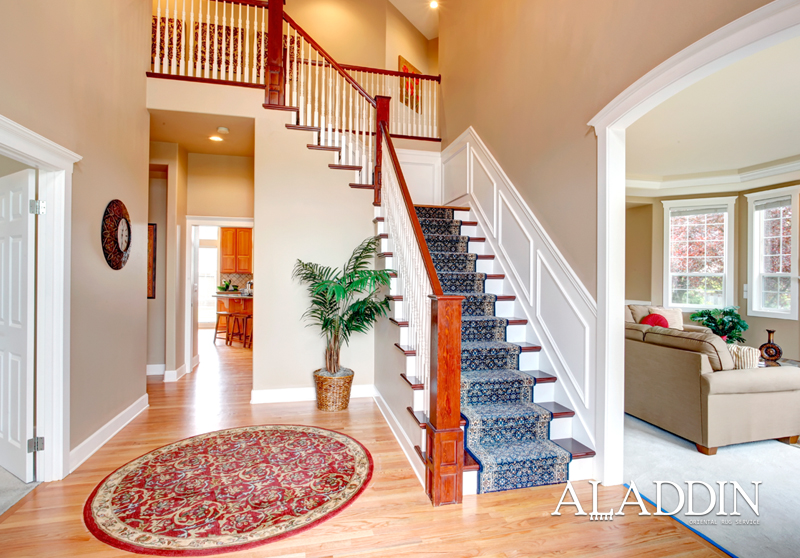The general feels, looks, durability and monetary values of a rug are mainly based on what materials are used in its creation. If you really want a rug that meets your specific needs and lasts as long as it should, you should be aware of the range of materials available to you. In this blog post, the experts at Aladdin Rug and Carpet will help delineate the differences between types of natural and synthetic rugs.
Natural Rugs
These rugs are made of plant or animal based fibers.
Wool
This widely used rug material is the most common material used in high quality area pile based rugs. Wool can come from sheep, goats, alpacas, or llamas. It’s resilient and durable, being much longer lasting than synthetics. It absorbs and holds dyes with lots of success, and is naturally stain, water, and fire resistant – as well as resisting dust mites.
Cotton
This naturally strong and durable fiber can easily absorb and retain many types of dyes. It’s often used in rug making with a wool blend, as many people find that the combination of materials is very comfortable on bare feet. Cotton wool blend rugs are also less expensive than all wool rugs, but are somewhat less durable than them.
Sisal
This plant fiber is made from the leaves of the Agave Sisalana plant, also known as American Aloe or the Century Plant. It’s from Central America, but is now grown in Mexico, Java, and East Africa. It is often used in all plant based rugs for it’s fine, long fibers that can be processed into smooth yarn like material. They are anti-static, absorb sound, flame retardant, and have long longevity.
Jute
This material made from mostly Indian and Chinese stem fiber plants is good for making durable fabrics due to its firmness and stability. Just like with other plant fibers like sisal, jute looks great in rugs, but it can also be course and not stain-proof – so it’s usually blended with softer or more stain resistant materials in order to make rugs.
Seagrass
This material is made from wetland plants with grassy stems. It’s known to be non-pourous with a naturally smooth texture, and has a hay color and smell to it, both of which disappear over time.
Bamboo
This wood like material is mostly found in Japanese and Chinese regions. It’s vastly durable, making it a great choice for any heavily trafficked rug, and offers fantastic bang for your buck – not to mention being available in a massive variety of style and size options.
Silk
This natural fiber is known for it’s luxurious shine, and is the most high valued rug fiber; even some added silk components can vastly raise the price of a rug. Silk rugs should only be cleaned and cared for by professional rug cleaners.
Synthetics
Silk is a good place to segway into this article’s discussion of synthetic materials, as there’s lots of faux silk on the market, usually made of viscose or rayon polyesters. Mercerized cotton is also sometimes substituted for silk, usually in rug accents or in making shorter, more dense pile rugs.
Viscose
This wood pulp based material is shiny, but when used by itself can easily get matted – however, when combined with other materials or only used as an accent, it can effectively substitute the more expensive real silk.
Rayon
This material is also based in wood (in tree cellulose) and is very similar to silk in appearance and look, however it can melt if it gets exposed to fire.
Acrylic
This fiber material is synthetic, and is sometimes blended with other materials to provide the appearance of a wool rug.
Nylon
This synthetic material is known for strength and uniformity as well as its ability to resist staining and soiling. They are available in tons of colors and are easily cleaned. Their strong nature makes them a fantastic choice for placement underneath furniture or heavily trafficked areas, and they usually cost way less than rugs made from natural materials – however they simply don’t last as long as a good quality wool or silk rug.
Polypropylene / Olefin
These petroleum based fibers are a product of propylene and ethylene gases, and when used in rugs can add strength, colorfastness, quick-drying ability, abrasion resistance, mildew resistance, and stain/soiling resistance. Rugs that are made from these materials usually cost less than other similar rugs. Olefin rugs are almost wooly, and polypropylene can be heat treated to make them last longer, and gain a matte sheen that appears more like wool. These rugs are lightweight, however, making them not an ideal choice for high traffic areas.





